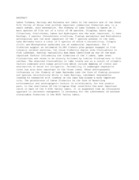| dc.contributor.author | Muchiri, Mucai | |
| dc.date.accessioned | 2015-10-15T11:20:16Z | |
| dc.date.available | 2015-10-15T11:20:16Z | |
| dc.date.issued | 1997 | |
| dc.identifier.uri | http://karuspace.karu.ac.ke/handle/20.500.12092/1606 | |
| dc.description.abstract | Lakes Turkana, Baringo and Naivasha are lakes in the eastern arm of the Great Rift Valley of Kenya that provide important commercial fisheries and, to a small extent, also recreation. The fishery of Lake Turkana is based on 12 main species of fish out of a total of 48 species. Tilapias, Lates spp., Citharinus, Distichodus, Labeo and Hydrocynus are the most important. In Lake Baringo, 3 species (Oreochromis niloticus, Clarias gariepinus and Protopterus aethiopicus) are the most important of the 7 species present in the lake. Lake Naivasha hosts a total of 5 species of which O.leucostictus, Tilapia ziilii and Micropterus salmoides are of commercial importance. The 3 fisheries support an estimated 10,000 fishers plus people engaged in fish industry related services. Yet these fisheries depict wide fluctuations in fish landings. Habitat variability has been identified as one of the most important factors influencing the fisheries of the 3 lakes. Lake level fluctuations are shown to be closely followed by similar fluctuations in fish catches. The observed fluctuations in lake levels are as a result of climatic factors combined with human activities which include damming of rivers and abstraction of water for irrigation. Variability in submerged vegetation cover has also been important in the three lakes. Other anthropogenic influences on the fishery of Lake Naivasha take the form of fishing pressure and species introductions while in Lake Baringo, catchment degradation leading to excessive silt loading in the lake has played a more important role. The persistence of these fisheries in the face of besetting environmental and anthropogenic factors is attributable, for the greater part, to the resilience of the tilapias that constitute the most important catch in each of the 3 Rift Valley lakes. It is suggested that an integrated approach to catchment management is necessary for the achievement of maximum sustainable fisheries in the Rift Valley lakes. | en_US |
| dc.language.iso | en | en_US |
| dc.publisher | CSIRO, Collingwood (Australia) | en_US |
| dc.subject | ake fisheries; Fishery resources; Catch composition; Stock assessment; Fishery management; Environmental effects; Man-induced effects; Tilapia; Oreochromis; Kenya, Rift Valley, Baringo L.; Kenya, Rift Valley, Turkana L.; Kenya, Rift Valley, Naivasha L. | en_US |
| dc.title | Fluctuations in the fisheries of Kenya's Rift Valley lakes: Causes and prospects for the future | en_US |
| dc.type | Book chapter | en_US |
